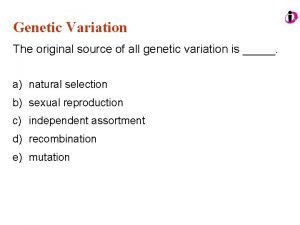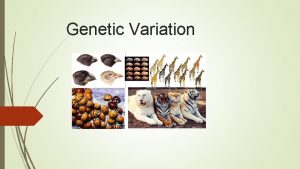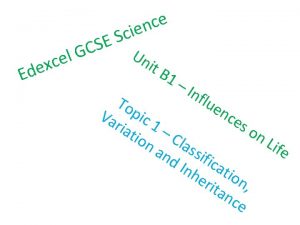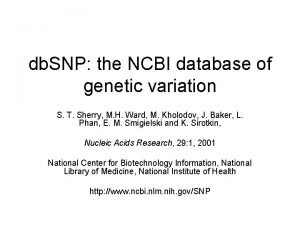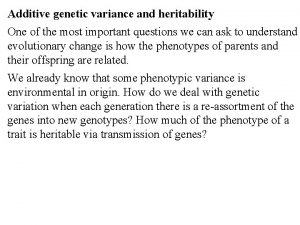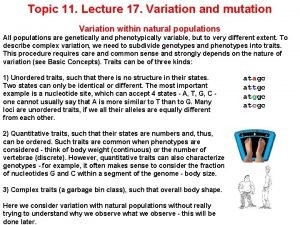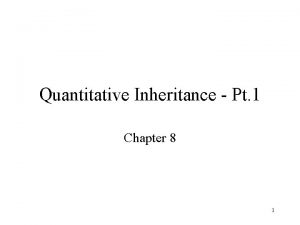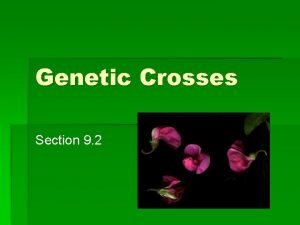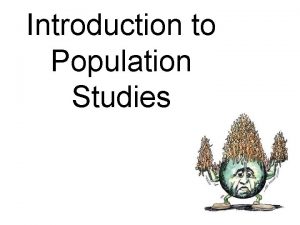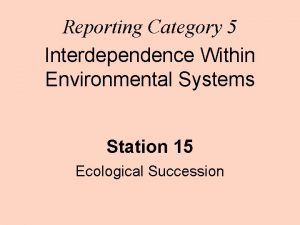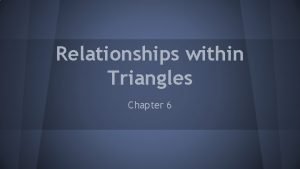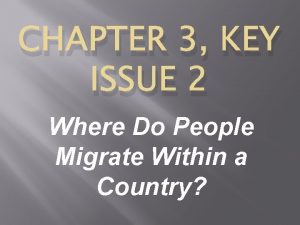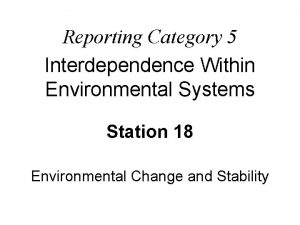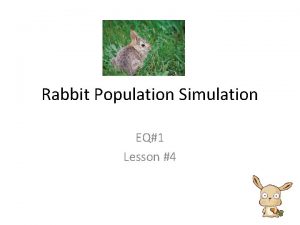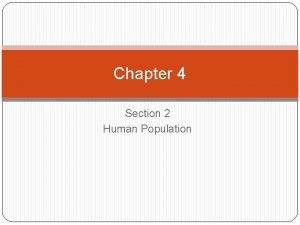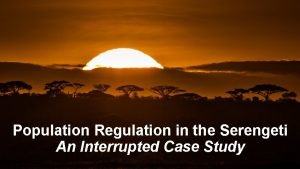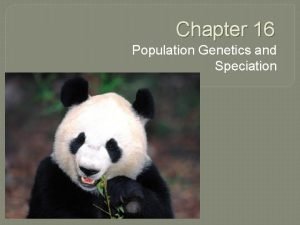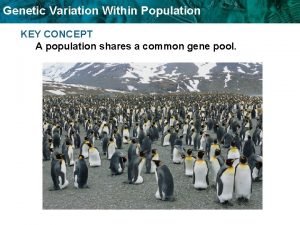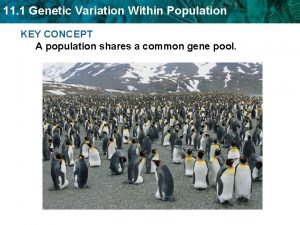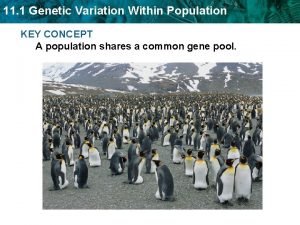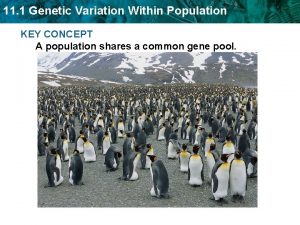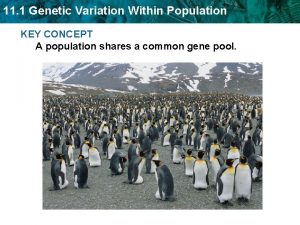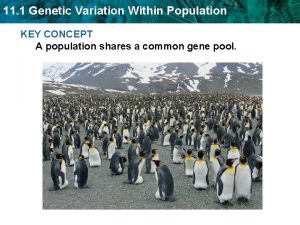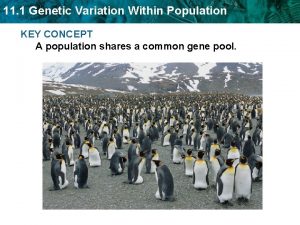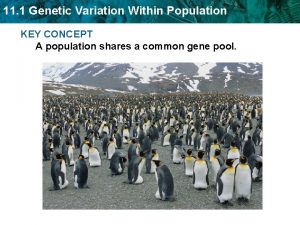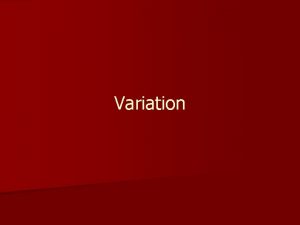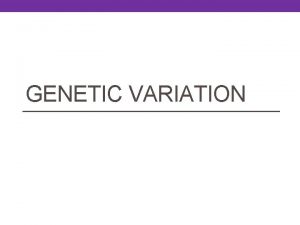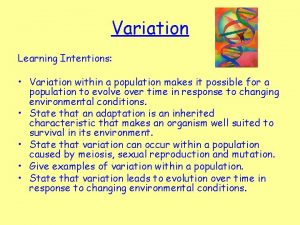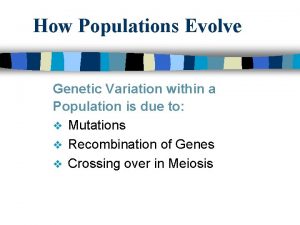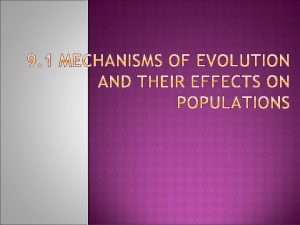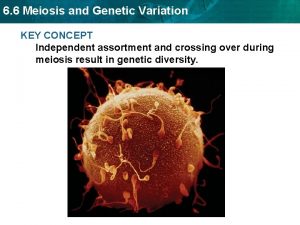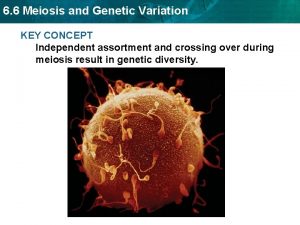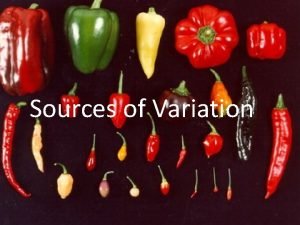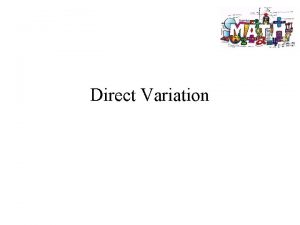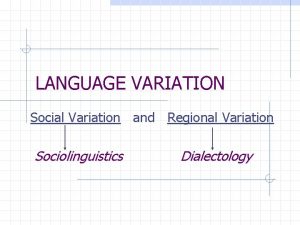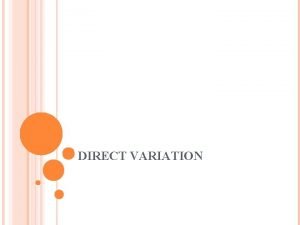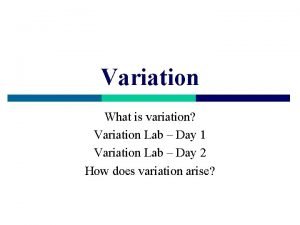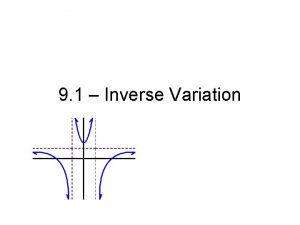11 1 Genetic Variation Within Population KEY CONCEPT










































- Slides: 42

11. 1 Genetic Variation Within Population KEY CONCEPT A population shares a common gene pool.

11. 1 Genetic Variation Within Population Genetic variation in a population increases the chance that some individuals will survive. • Genetic variation leads to phenotypic variation. • Phenotypic variation is necessary for natural selection. • Genetic variation is stored in a population’s gene pool. – made up of alleles in a population – allele combinations form when organisms have offspring

11. 1 Genetic Variation Within Population • Allele frequencies measure genetic variation. – measures how common allele is in population – can be calculated for each allele in gene pool

11. 1 Genetic Variation Within Population Genetic variation comes from several sources. • Mutation is a random change in the DNA of a gene. – can form new allele – can be passed on to offspring if in reproductive cells • Recombination forms new combinations of alleles. – usually occurs during meiosis – parents’ alleles arranged in new ways in gametes

11. 1 Genetic Variation Within Population Genetic variation comes from several sources. • Hybridization is the crossing of two different species. – occurs when individuals can’t find mate of own species – topic of current scientific research

11. 2 Natural Selection in Populations KEY CONCEPT Populations, not individuals, evolve.

11. 2 Natural Selection in Populations Natural selection acts on distributions of traits. • A normal distribution graphs as a bell-shaped curve. – highest frequency near mean value – frequencies decrease toward each extreme value • Traits not undergoing natural selection have a normal distribution.

11. 2 Natural Selection in Populations Natural selection can change the distribution of a trait in one of three ways. • Microevolution is evolution within a population. – observable change in the allele frequencies – can result from natural selection

11. 2 Natural Selection in Populations • Natural selection can take one of three paths. – Directional selection favors phenotypes at one extreme.

11. 2 Natural Selection in Populations • Natural selection can take one of three paths. – Stabilizing selection favors the intermediate phenotype.

11. 2 Natural Selection in Populations • Natural selection can take one of three paths. – Disruptive selection favors both extreme phenotypes.

11. 3 Other Mechanisms of Evolution KEY CONCEPT Natural selection is not the only mechanism through which populations evolve.

11. 3 Other Mechanisms of Evolution Gene flow is the movement of alleles between populations. • Gene flow occurs when individuals join new populations and reproduce. • Gene flow keeps neighboring populations similar. • Low gene flow increases the chance that two populations will evolve into different species. bald eagle migration

11. 3 Other Mechanisms of Evolution Genetic drift is a change in allele frequencies due to chance. • Genetic drift causes a loss of genetic diversity. • It is most common in small populations. • A population bottleneck can lead to genetic drift. – It occurs when an event drastically reduces population size. – The bottleneck effect is genetic drift that occurs after a bottleneck event.

11. 3 Other Mechanisms of Evolution • The founding of a small population can lead to genetic drift. – It occurs when a few individuals start a new population. – The founder effect is genetic drift that occurs after start of new population.

11. 3 Other Mechanisms of Evolution • Genetic drift has negative effects on a population. – less likely to have some individuals that can adapt – harmful alleles can become more common due to chance

11. 3 Other Mechanisms of Evolution Sexual selection occurs when certain traits increase mating success. • Sexual selection occurs due to higher cost of reproduction for females. – males produce many sperm continuously – females are more limited in potential offspring each cycle

11. 3 Other Mechanisms of Evolution • There are two types of sexual selection. – intrasexual selection: competition among males – intersexual selection: males display certain traits to females

11. 4 Hardy-Weinberg Equilibrium There are five factors that can lead to evolution.

11. 4 Hardy-Weinberg Equilibrium • Genetic drift changes allele frequencies due to chance alone.

11. 4 Hardy-Weinberg Equilibrium • Gene flow moves alleles from one population to another.

11. 4 Hardy-Weinberg Equilibrium • Mutations produce the genetic variation needed for evolution.

11. 4 Hardy-Weinberg Equilibrium • Sexual selection selects for traits that improve mating success.

11. 4 Hardy-Weinberg Equilibrium • Natural selection selects for traits advantageous for survival.

11. 4 Hardy-Weinberg Equilibrium • In nature, populations evolve. – expected in all populations most of the time – respond to changing environments

11. 5 Speciation Through Isolation KEY CONCEPT New species can arise when populations are isolated.

11. 5 Speciation Through Isolation The isolation of populations can lead to speciation. • Populations become isolated when there is no gene flow. – Isolated populations adapt to their own environments. – Genetic differences can add up over generations.

11. 5 Speciation Through Isolation • Reproductive isolation can occur between isolated populations. – members of different populations cannot mate successfully – final step to becoming separate species • Speciation is the rise of two or more species from one existing species.

11. 5 Speciation Through Isolation Populations can become isolated in several ways. • Behavioral barriers can cause isolation. – called behavioral isolation – includes differences in courtship or mating behaviors

11. 5 Speciation Through Isolation • Geographic barriers can cause isolation. – called geographic isolation – physical barriers divide population • Temporal barriers can cause isolation. – called temporal isolation – timing of reproductive periods prevents mating

11. 6 Patterns in Evolution KEY CONCEPT Evolution occurs in patterns.

11. 6 Patterns in Evolution through natural selection is not random. • Natural selection can have direction. • The effects of natural selection add up over time.

11. 6 Patterns in Evolution • Convergent evolution describes evolution toward similar traits in unrelated species.

11. 6 Patterns in Evolution • Divergent evolution describes evolution toward different traits in closely related species. kit fox red fox ancestor How do convergent and divergent evolution illustrate the directional nature of natural selection?

11. 6 Patterns in Evolution Species can shape each other over time. • Two or more species can evolve together through coevolution. – evolutionary paths become connected – species evolve in response to changes in each other

11. 6 Patterns in Evolution • Coevolution can occur in beneficial relationships.

11. 6 Patterns in Evolution • Coevolution can occur in competitive relationships, sometimes called evolutionary.

11. 6 Patterns in Evolution Species can become extinct. • Extinction is the elimination of a species from Earth. • Background extinctions occur continuously at a very low rate. – occur at roughly the same rate as speciation – usually affects a few species in a small area – caused by local changes in environment

11. 6 Patterns in Evolution • Background extinctions occur continuously at a very low rate. – occur at roughly the same rate as speciation – usually affects a few species in a small area – caused by local changes in environment

11. 6 Patterns in Evolution • Mass extinctions are rare but much more intense. – destroy many species at global level – thought to be caused by catastrophic events – at least five mass extinctions in last 600 million years

11. 6 Patterns in Evolution Speciation often occurs in patterns. • A pattern of punctuated equilibrium exists in the fossil record. – theory proposed by Eldredge and Gould in 1972 – episodes of speciation occur suddenly in geologic time – followed by long periods of little evolutionary change – revised Darwin’s idea that species arose through gradual transformations

11. 6 Patterns in Evolution • Many species evolve from one species during adaptive radiation. – ancestral species diversifies into many descendent species – descendent species usually adapted to wide range of environments
 When does crossing over occur during meiosis?
When does crossing over occur during meiosis? Chapter 4 population ecology section 1 population dynamics
Chapter 4 population ecology section 1 population dynamics Population ecology section 1 population dynamics
Population ecology section 1 population dynamics Chapter 4 section 1 population dynamics answer key
Chapter 4 section 1 population dynamics answer key Gene flow vs genetic drift
Gene flow vs genetic drift Genetic programming vs genetic algorithm
Genetic programming vs genetic algorithm Genetic programming vs genetic algorithm
Genetic programming vs genetic algorithm Genetic drift vs genetic flow
Genetic drift vs genetic flow What is the difference between genetic drift and gene flow
What is the difference between genetic drift and gene flow Components of genetic variation
Components of genetic variation Genetic variation examples
Genetic variation examples What is inherited variation
What is inherited variation Db directo snp
Db directo snp Additive genetic variation definition
Additive genetic variation definition Genetic variation
Genetic variation Dominant genetic variance
Dominant genetic variance Direct variation constant of variation
Direct variation constant of variation Direct and inverse variation graphs
Direct and inverse variation graphs Coefficient of determination formula in regression
Coefficient of determination formula in regression 90 of the canadian population lives within
90 of the canadian population lives within Chapter 11 genetic disorders concept mapping
Chapter 11 genetic disorders concept mapping Population ecology section 1 population dynamics
Population ecology section 1 population dynamics Chapter 4 lesson 4: metamorphic rocks answer key
Chapter 4 lesson 4: metamorphic rocks answer key Key concept builder lesson 1 what are waves answer key
Key concept builder lesson 1 what are waves answer key Brainpop heredity worksheet answer key
Brainpop heredity worksheet answer key Genetic crosses section 9-2 review
Genetic crosses section 9-2 review Key partners in business model canvas
Key partners in business model canvas Key partners key activities key resources
Key partners key activities key resources Concept 3 population ecology
Concept 3 population ecology The concept of population
The concept of population Exponential population growth
Exponential population growth The concept of population
The concept of population Population growth concept map answers
Population growth concept map answers Interdependence within environmental systems
Interdependence within environmental systems Chapter 6 relationships within triangles answer key
Chapter 6 relationships within triangles answer key Key issue 2: where do people migrate within a country?
Key issue 2: where do people migrate within a country? Interdependence within environmental systems
Interdependence within environmental systems Modeling population growth rabbits answer key
Modeling population growth rabbits answer key Chapter 4 section 2 human population answer key
Chapter 4 section 2 human population answer key Chapter 4 section 1 population dynamics
Chapter 4 section 1 population dynamics Ecology
Ecology Population regulation in the serengeti answer key
Population regulation in the serengeti answer key Population genetics and speciation worksheet answer key
Population genetics and speciation worksheet answer key









